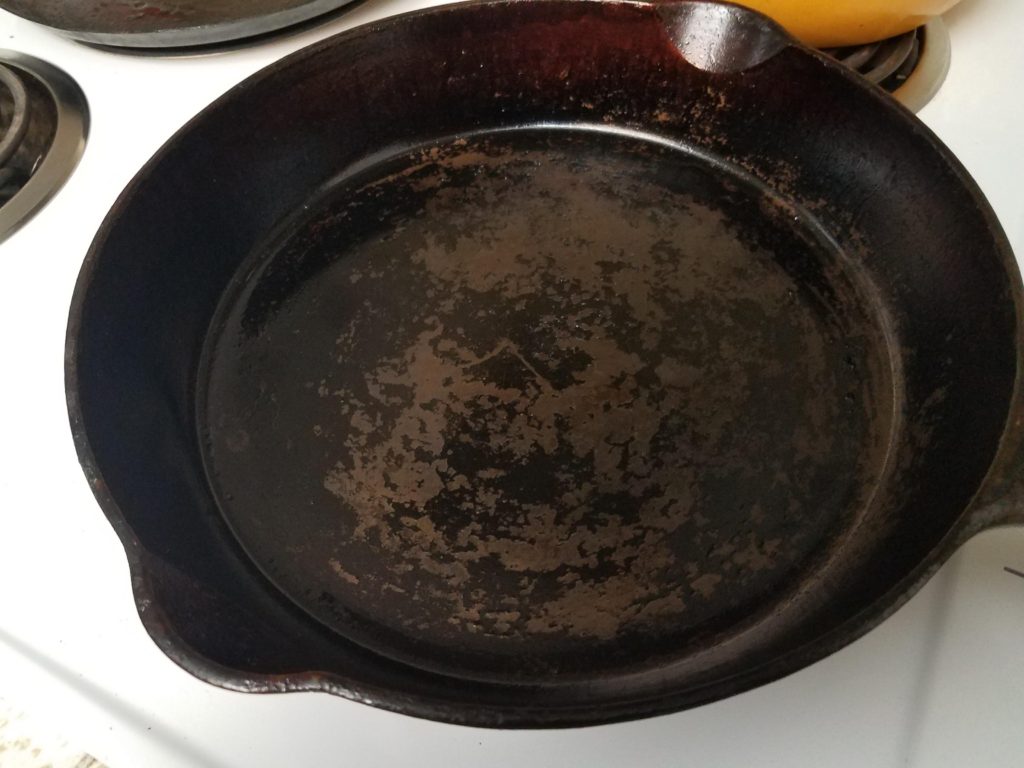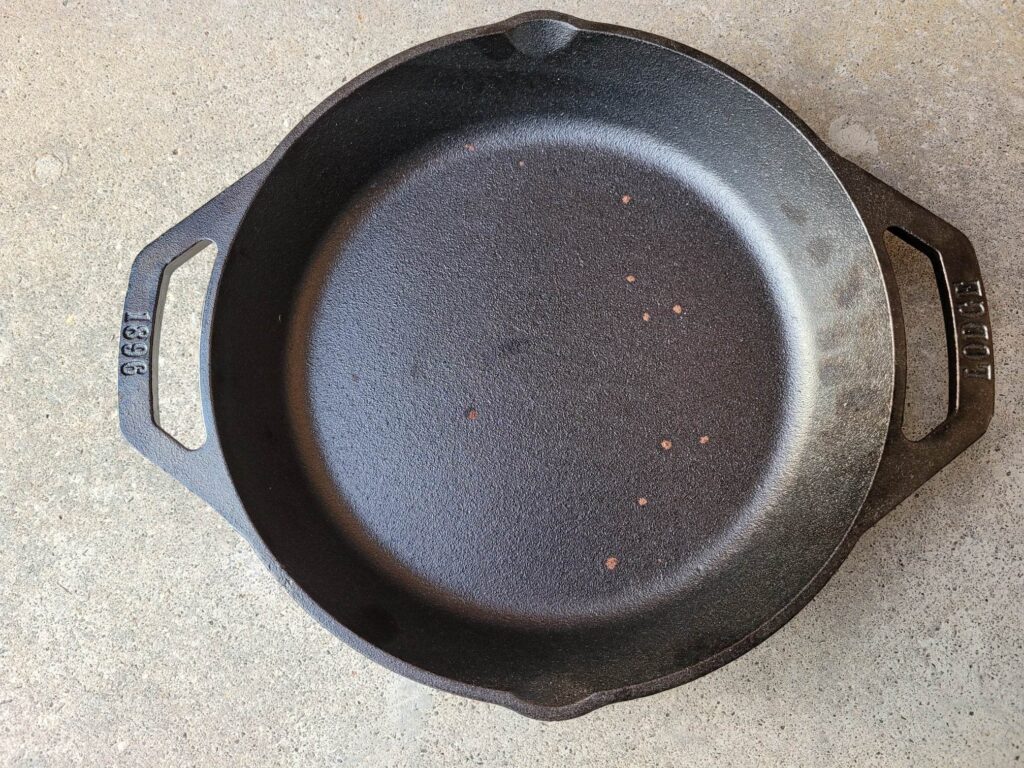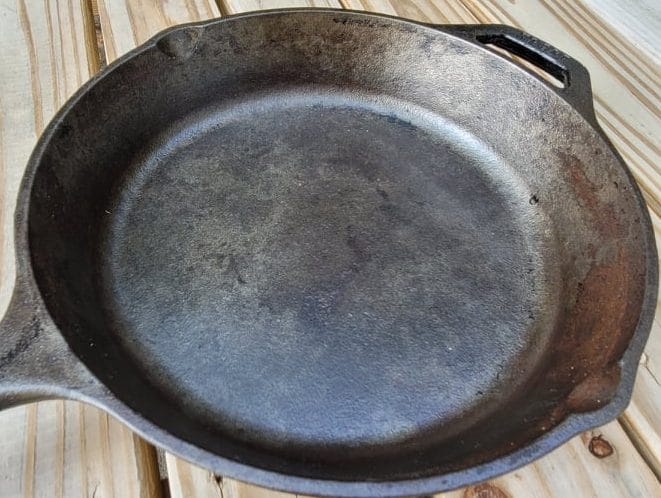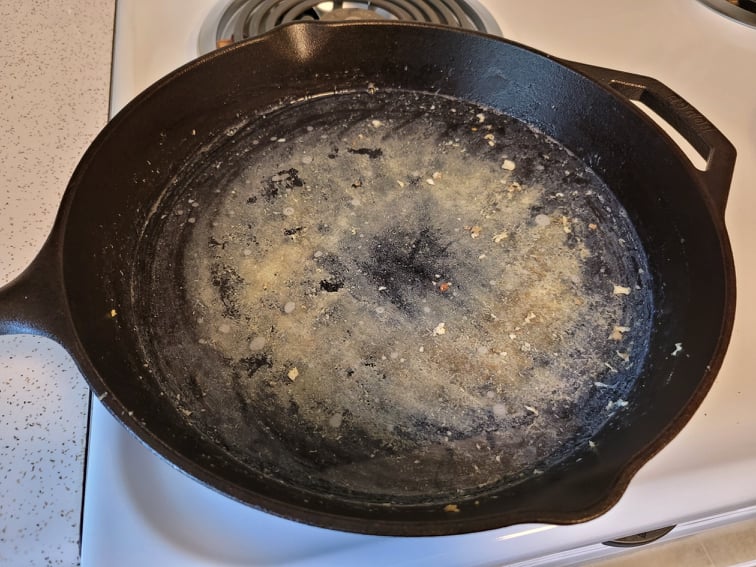Did you get a new cast iron skillet for the holidays? I got a few new pieces and I’m so excited to start cooking with them! But this begs the question, Do you have to season a new cast iron skillet first, or can you just use it right out of the box?
You can use new, pre-seasoned cast iron cookware right out of the box. Simply rinse and dry, then pre-heat the pan, add oil, and cook. Seasoning improves with use. However, avoid cooking acidic foods like tomato or wine-based dishes until the seasoning layer has been built up.
In this article, I’ll show you:
- How to get started cooking with your new cast pan iron right away
- The best foods to cook in a new cast iron pan to help “break it in”
- Which foods to avoid cooking in your new pan until the seasoning layer is stronger
- How to season a cast iron pan the right way, and
- How to troubleshoot and fix common cast iron problems
But first, a quick word about cast iron seasoning and why it’s essential for pan protection and cooking success.
What Is Cast Iron Seasoning? Why Is It Important?
Cast iron seasoning is essentially multiple thin layers of oil baked onto the surface of the pan. This is done at a high temperature, which causes the liquid oil to bond with the iron on a molecular level and transform into a slick, hard surface through a process called polymerization. This creates the smooth, easy-release finish you want on a cast iron pan.
Without proper seasoning, cast iron is prone to rust. Cooking in an under-seasoned skillet will also cause your food to stick like crazy, and even possibly taste like metal. (Bleh!)
What Is Pre-Seasoning?
Most (if not all) new cast iron skillets undergo one or two rounds of seasoning at the factory. This is called pre-seasoning, and it has some advantages. First, it protects the cast iron from rust by creating a barrier between the iron and moisture in the environment. Second, it allows users to start cooking with the pan right out of the box. And third, The pre-seasoning creates a good base for additional seasoning layers.
The Difference Between a Pre-Seasoned and Fully-Seasoned Pan
While the pre-seasoning on a pan is a good place to start, going the extra mile and performing an additional one, two, or even three rounds of seasoning on your new cast iron cookware is the gold standard.
For example, these two photos compare the difference between a new, pre-seasoned skillet and a fully-seasoned one. It’s actually the same skillet in each photo. I’ve had it for a few months, but it has never been cooked in.


In the first photo, you can tell the pan appears to be a bit more grey in color. You can also see a weird oily swirl in the middle (that wouldn’t go away even after washing with soap) and some small rust spots where the seasoning chipped off.
In the second photo, the same skillet is a deeper, much more uniform black color after undergoing three additional rounds of seasoning with grapeseed oil. The rust spots are gone and the iron is now fully protected.
Should I Season My New Cast Iron Skillet, Or Can I Use It Right Away?
You can definitely use new, pre-seasoned cast iron cookware right out of the box. Although I always recommend additional seasoning prior to the first use, not everybody wants to do that. And that’s okay because the seasoning typically improves with consistent use and the right care.
How To Use A Brand New Cast Iron Skillet
To use your new cast iron cookware, first, rinse and dry it with a towel. Then, pre-heat the pan for 3-5 minutes on a stovetop burner over low-medium heat. Never go above medium heat, as cast iron gets SUPER HOT and can start to smoke. Next, add plenty of oil and cook your food.
New Cast Iron Skillet Cleaning And Care
After cooking and when the pan is cool to the touch, wipe out the grease and food residue. Wash the pan with warm water and use mild dish soap or castile soap if you want. Dry the pan really well with a towel. Don’t let cast iron air dry, or it will rust. Lastly, rub a small amount of cooking oil all over the inside of the pan and buff it off with a lint-free cloth. The oil protects and conditions the iron until its next use.
Best Foods To Cook In A New Cast Iron Skillet
The best foods to cook in a new cast iron skillet are those that are high in fat and low in starches and sugars. Here are some of the foods I cook to “break in” my new skillets:
- Bacon (without sugar)
- Hamburgers
- Sausage
- Non-starchy vegetables (with oil), such as a stir-fry mix
- Cornbread (with oil)
It’s also important to remember to preheat your pan over low-medium heat and cook with plenty of oil or fat to decrease the chances of food sticking to a new skillet.
Foods To Avoid Cooking In A New Cast Iron Skillet
Before your new skillet is fully seasoned, it’s best to avoid certain foods and ingredients that are prone to sticking or that may damage the thin pre-seasoning layer. Here are foods I typically avoid at first:
- Tomato-based sauces and soups, ketchup
- Wine-based dishes
- Lean proteins, such as chicken breast or ground turkey
- Scrambled eggs
- Sugary foods or sauces, such as barbecue sauce
- Starchy foods like potatoes or rice
Once your skillet is fully seasoned, it’s fine to cook all of these foods.
How To Season A New Cast Iron Skillet
Follow these easy steps to properly season your cast iron:
1. Wash The Pan Thoroughly
Wash the pan with dish soap and water to remove dirt, grease, and food residue. Use a scrubbing sponge or nylon brush. Avoid steel wool or scouring pads.
2. Dry and Pre-Heat The Pan
Dry the pan with a towel. Then, heat it on a stovetop burner over low heat or in the oven at 200 degrees F for 5 minutes to evaporate moisture.
3. Lightly Oil and Buff The Pan
When the pan is cool enough to handle, apply a very light coat of oil or seasoning wax to all surfaces. I prefer grapeseed oil, canola oil, or Buzzywaxx products for seasoning. Use a lint-free cloth to buff the pan and remove all of the excess oil. And I mean really buff your pan well! Wipe it down as if you’re trying to remove all the oil you just put on it. There will still be enough oil on the iron to produce a good seasoning layer without becoming sticky from excess.
4. Heat The Pan In The Oven
Heat the oiled pan upside down in the oven at 450 degrees F for one hour. When it’s done, leave the pan in the oven, crack the oven door open to vent, and allow it to cool. Repeat this process for a total of four rounds to build the best seasoning layer.

For more info and to find out which oil is best for seasoning, check out my helpful step-by-step guide to cast iron seasoning.
New Cast Iron Troubleshooting
Cast iron cookware is actually pretty simple to use and care for once you get the hang of it. But occasionally, pan problems happen. Here are the most common problems I get asked about, along with easy solutions.
My New Cast Iron Skillet Is Flaking. How Do I Fix It?

The thin layer of pre-seasoning applied to cast iron pans by the factory is a great starting place, but it’s just not strong enough yet to hold up to acidic foods or scratches from metal utensils.
If your cast iron pan is flaking, don’t worry; It is still safe to use. The flakes are made of carbon and are not harmful.
To fix and prevent flaking:
- Scrub your pan thoroughly with a scouring sponge or chainmail scrubber to remove loose seasoning flakes.
- Rinse and dry the pan well.
- Season your pan in the oven a minimum of two times (preferably three or four times) with grapeseed, canola, or vegetable oil to build a strong seasoning layer.
- Use bamboo utensils to prevent scratching the seasoning.
Why Are There Rust Spots On My New Cast Iron Pan?

Rust happens when bare iron is exposed to oxygen and moisture in the air. The thin pre-seasoning layer on new cast iron pans is prone to wearing away or getting scratched. This can happen while cooking or even when storing new pans stacked on top of each other, leaving the iron exposed and causing little rust spots.
To fix and prevent rust spots:
- Wash and dry the pan well.
- Season your pan in the oven three to four times with grapeseed, canola, or vegetable oil to build a strong seasoning layer.
- Store pans in a dry, well-ventilated area. Don’t store pans with the lids on. Place a paper towel layer between stacked pans to prevent scratches.
Why Does My Food Taste Like Metal?

When done correctly, the seasoning on a cast iron pan actually creates a barrier between the iron and your food. If the seasoning layer is very thin or has flaked off, the bare iron will be exposed. This can cause food to take on a metallic taste. While it’s not harmful, it’s not appetizing, either.
To prevent metallic-tasting food:
- Wash and dry the pan well.
- Season your pan in the oven three to four times with grapeseed, canola, or vegetable oil to build a strong seasoning layer.
Why Is Food Sticking To My Cast Iron Pan?

Food is more prone to sticking to a cold, under-seasoned pan. But, even with a well-seasoned pan, some foods just stick more than others. This is particularly true for foods high in sugar, starch, and protein, and low in fat. While it may not be possible to completely prevent food from sticking to cast iron, here’s how to decrease the chances that it will.
To decrease stuck food:
- Make sure your pan is well-seasoned. I recommend three to four rounds of seasoning in the oven for best cooking performance.
- Cook with plenty of oil or fat! Hot oil creates a barrier between your food and the pan, reducing the chances of sticking.
- Preheat your pan over low-medium heat on the stovetop burner for about five minutes. Once it’s hot, add the oil, then the food.
- For baked items like cornbread: Place the pan in the oven, turn it on, and let the oven and pan preheat together. Once the pan is hot, add oil, then add the cornbread mix. P.S. – Cooking cornbread is a great way to break in a new skillet!
Summary
In conclusion, no, you don’t have to season a new cast iron skillet before using it for the first time. With continued use and the right care, the seasoning layer will eventually build up over time.
However, my personal preference is to always season a new cast iron skillet before first use. Remember, a strong seasoning layer means fewer pan problems and better cooking performance!
This post may contain affiliate links. This means if you click on a link and make a purchase, I will receive a small commission, at no cost to you, that makes it possible for me to keep the Campfires and Cast Iron site up and running. Please see our disclosure policy for details.



